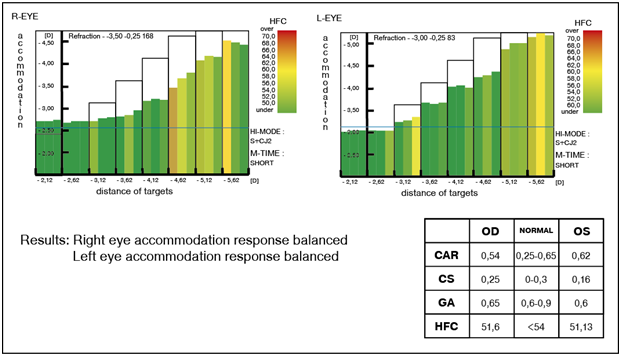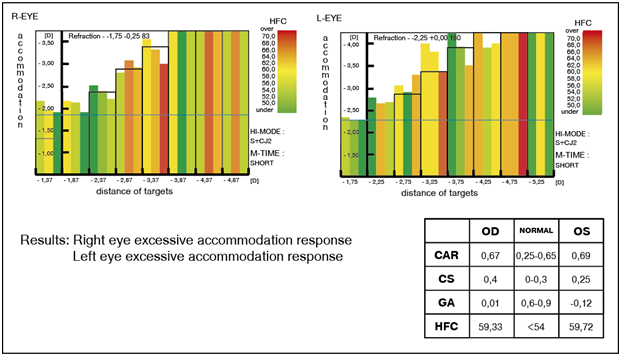Advances in
eISSN: 2377-4290


Research Article Volume 9 Issue 3
City Eye Out-patient Consulting Center for Children & Adults №7, Saint Petersburg, Russia
Correspondence: VO Sokolov, City Eye Out-patient Consulting Center for Children & Adults №7, Saint Petersburg, Russia
Received: February 26, 2019 | Published: May 3, 2019
Citation: Sokolov VO, Ershova RV, Kechek KA. Computer accommodation: estimation of accommodation response state of metropolis school children. Adv Ophthalmol Vis Syst. 2019;9(3):60-64. DOI: 10.15406/aovs.2019.09.00347
Purpose: We aimed to develop our own method for estimating the parameters of accommodation charts received with Auto Refract-Keratometer Righton Speedy-K ver. MF-1 instrument. To find out the main types of accommodative response in myopic and emmetropic school children with different degrees of refractive error. To determine the values of developed parameters for different variants of the accommodative response.
Materials and methods: The study was conducted at the «City Eye Out- patient Consulting Center for Children & Adults №7» in Saint-Petersburg (Russia). We aimed to develop our own quantitative assessment program for the accommodative response data received with the Auto Refract-Keratometer Righton Speedy-K ver. MF-1 instrument. 2321 children and teenagers aged from 7 to 17 years participated in this work. For a comparative assessment of the basic parameters of accommodation in schoolchildren, accommodation measurement was performed in 262 children of the same age with myopia and emmetropia.
Results: We developed our own method for the mathematical analysis of the accommodation data obtained using the Righton Speedy-K ver. MF-1 (Japan). Four main types of accommodative response were identified, coefficients for each type were determined. It was determined that for children with myopia, regardless of age, there are three main variants of accommodative response in equal shares, and in children with emmetropia, variants of normal accommodation diagram prevail.
Relevance: The study of accommodation in children and adults for many years traditionally receives much attention.1–3 In clinical practice the most common is the study of absolute and relative accommodation, indicators of which are largely subjective.4 Information about objective accommodation in children is rare, and only with the advent of the Auto Refract-Keratometer Righton Speedy-K ver. MF-1 automatic refractor, it became possible to quantify the basic accommodation parameters, determine their age norms and classify violations.5
Purpose: We aimed to develop our own method for calculating the mathematical parameters for accommodation charts received with Auto Refract-Keratometer Righton Speedy-K ver. MF-1 instrument and to determine their values for various types of accommodative response on the basis of developed method to evaluate results of objective computer accommodography in school children with close to emmetropic refraction or different degrees of myopia.
Materials and methods: Auto Refract-Keratometer Righton Speedy-K ver. MF-1 with a built-in program for the study of micro fluctuations of accommodation allows to register changes of refraction in response to a visual stimulus presented at different distances (accommodative response), which is shown on the display of the device as a histogram. In addition to the magnitude of the accommodative response, expressed in diopters, the instrument performs frequency analysis of accommodative micro fluctuations (AMF) using the Fourier transform method. AMF’ High-Frequency Component - High-Frequency Components (HFC) has a range from 50 to 80 micro fluctuations per minute.6,7 To assess the level of HFC, VV Zharov et al.8 proposed to calculate the average level of HFC (HFCcp) of the entire study and designate it as micro fluctuation coefficient (MFC):7,8
Where HFCi is the frequency of micro fluctuations of each measurement
The same authors proposed two more coefficients: the coefficient of the accommodation response (CAR), which characterizes the degree of tension of the ciliary muscle; growth rate of the accomodgram (GA) - to assess the growth (decrease) of the accomodogram, as well as the coefficient of stability (SC), which, however, according to the authors, was not so informative. In order to create our own program of quantitative assessment of the accommodation response on the Righton Speedy-K ver. MF-1 we analyzed 2321 accomodograms of children with emmetropia and myopia.
For a comparative assessment of the basic accommodation parameters in schoolchildren with myopia and emmetropia, accommodation measurements were performed for 262 children aged 7–17 years, some of them using the Righton Speedy-K ver. MF-1 instrument. The main group consisted of 184 children (368 eyes) aged 7-17 years with myopic manifest refraction. Control group 78 children without ocular pathology (156 eyes), of same age with manifest refraction (according to retinoscopy), on average 0.03 ±0.03 D (Myopia 0.80 ± 0.05 D - according to automatic refractometry). The work was carried out on the basis of the City Eye Out-patient Consulting Center for Children & Adults №7 of Saint-Petersburg (Director Dr VO Sokolov).
After testing various methods for analyzing the quantitative characteristics of accommodation diagrams, we suggested using four coefficients to quantify the data of each patient examined: CAR [KAO] (accommodative response coefficient), GA [КР] (growth rate), SC [KYS] (stability coefficient), CMF [KMF] (micro fluctuations coefficient) and proposed our own method for calculation of CAR, GA and SC. CAR characterizes the degree of tension of the ciliary muscle, depends on the level of accommodative response, compared with the stimulus. The coefficient is calculated as the average value of the slope angle of the average accommodative response curve:
where ARi is the accommodative response in diopters, ASi is the accommodative stimulus in diopters, R - is the refraction of the eye, n - is the number of measurement columns.
GA is the growth rate of the accommodative response. This ratio was calculated as follows:
Where ASi is the accommodative stimulus in diopters, ARiis the accommodative response, CS evaluates the sustainability of the accommodative response. The coefficient is calculated as the standard deviation of the mean value of the accommodation response (variance).
Where CARi is the slope angle of the accommodative response for the i - the measurement.
The CMF (micro fluctuations coefficient) is used to estimate the tension of the accommodation response. The value of the CMF in response to the stimulus is transmitted by the device itself. The coefficient is calculated as the average level of the entire study.8 In order to assess the possibility of applying the above factors in clinical practice; we registered 2321 accommodograms of children with various types of refractive states from 2009 to 2011. After analyzing the accommodograms, we determined the normal values of the coefficients proposed above.3 In particular; the CAR normally ranges from 0.25 to 0.6 in conventional units. Smaller the value of coefficient, flatter the form of the histogram. The accommodogram has a stable form at values of CS ≤0.3 in conventional units. The greater the value of the coefficient, the more unstable is the histogram. The increasing gradient of the columns of the accommodogram and the gradualness of the voltage, expressed by the GA, corresponds to the values of this coefficient in the range from 0.6 to 0.9 in conv. units. Larger the GA, lower the histogram level. The expressiveness of the high-frequency component of accommodative micro fluctuations is characterized by the CMF and normally it should not exceed 54.0 microfluctuations/min. The higher the coefficient, the greater the tension of the ciliary muscle, and the red color prevails on the histogram. To simplify the analysis of the histogram, the program in question provides a conclusion that includes a table with the values of the coefficients characterizing the balanced accommodative response (norm) and the coefficients obtained during this study. Figure 1 presents the conclusion form for the study of the accommodation response on Speedy-K Auto Refract- Keratometer, ver. MF-1 (Righton, Japan) (Figure 1).
On the basis of the data obtained, four variants of the accommodation response were identified: balanced, weak, redundant, and labile, and the values of the accommodative coefficients for each were determined. The histogram in Figure 1 shows that the eye normally tracks a moving object. CMF is low. Visual fatigue is absent.
Figure 2 presents the conclusion form of the patient Sh., 15 years old, with a diagnosis of acquired progressive moderate myopia in both eyes.

Figure 1 The conclusion form of the patient S’ accommodation with low myopia received on the Speedy-K Auto Refract-Keratometer ver. MF-1 (Righton, Japan).

Figure 2 Form of the conclusion of automatic accommodation measurement of the patient Sh. with a weak accommodative response.
The histogram in Figure 2 demonstrates that the eye does not track a moving object (CAR <0.25 conv. units, GA> 0.9 conventional units, SC≤0.3 conv. units, CMF≤54.0 micro fluctuations/min. Figure 3 presents the form of the conclusion of the child G., 10 years old, with low myopia in combination with excessive accommodation tension.
The histogram in the Figure 3 demonstrates the case of an excessive tension of accommodation in a 10-year-old child with acquired progressive low myopia in both eyes. The level of accommodative response corresponds to the stimulus or exceeds it, is unstable, the frequency of micro fluctuations is increased (CAR> 0.6 conv. units, GA<0.6 conv. units, SC≥0.3 conventional units, CMF≥54.0 micro fluctuations/min.) Tension develops in the ciliary muscle. Figure 4 demonstrates the accommodation measurement in patient D., 13 years of age with acquired, hereditary progressive low myopia with unstable (labile) accommodation in the right eye.

Figure 3 Accommodation measurement of patient G., 10 years old, with excessive accommodation response.
Presented in Figure 4, the results of computer accommodation measurement (right eye) demonstrate the option of a labile accommodative response: in response to an approaching object, the eye, on the contrary, focuses on a distant object, which leads to a discrepancy between the position of the object and the position of the focus of the eye. The stability coefficient significantly exceeds the calculated norm (SC>0.6 conventional units), the frequency of micro fluctuations is increased (CMF>54.0 micro fluctuations/min.). We have analyzed the coefficients of the accommodation response in those accommodograms where the stability coefficient significantly exceeds the established normal values. It has been established that it is not possible to reliably estimate the value of the accommodative response coefficient and growth rate in such cases because of the false-normal values of these indicators. The distribution of variants of the accommodation response depending on the age and clinical refraction of the child is presented graphically (Figure 5). It was found that in children with emmetropia, accommodograms with a normal (balanced) accommodative response predominate; moreover, their share among other variants of accommodative response increases with age (p<0.01). At the same time, in children with myopia, all three main types of accommodative response are noted: balanced, weak, and excessive, with almost the same frequency (p>0.05). At the same time, most often they recorded accommodograms with an unbalanced accommodative response (p<0.001), and the number of accommodograms with a weak and redundant response was almost equal (p> 0.05).
The developed method for the mathematical analysis of the accommodogram obtained using the Righton Speedy-K ver. MF-1 (Japan) allows to quantitatively characterize the most informative indicators of the respondent's accommodative response and to objectify the assessment of altered accommodation among schoolchildren. Four main types of accommodative response are identified: balanced, weak, redundant, and labile, characterized by the corresponding values of the accommodogram. Based on the analysis of the accommodation response obtained using the Speedy-K ver. MF-1 in children with myopic refraction, it was found that in all age groups in equal shares there are three main variants of the accommodative response: tense, weak and balanced, and in children with emmetropia, the “normal” accommodograms reliably dominate, moreover, their proportion increases with age, which is consistent with the general ideas about the "maturation" of the accommodative apparatus.
None.
Author declares that there is no conflict of interest.

©2019 Sokolov, et al. This is an open access article distributed under the terms of the, which permits unrestricted use, distribution, and build upon your work non-commercially.